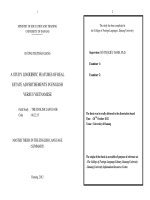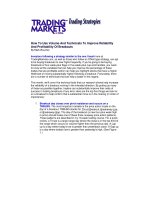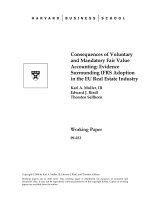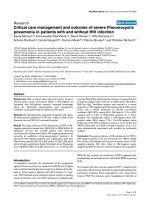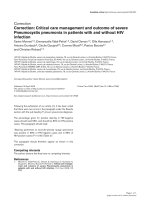Working capital management and profitability of real estate industry in Jordan: An empirical study
Bạn đang xem bản rút gọn của tài liệu. Xem và tải ngay bản đầy đủ của tài liệu tại đây (400.9 KB, 7 trang )
Journal of Applied Finance & Banking, vol. 7, no. 2, 2017, 49-57
ISSN: 1792-6580 (print version), 1792-6599 (online)
Scienpress Ltd, 2017
Working Capital Management and Profitability of Real
Estate Industry in Jordan: An Empirical Study
Basman Al Dalayeen1
Abstract
Working capital is described as the capital available to meet the day-to-day operations,
and depending on the industry, it could be a relatively high percentage of the total assets
of the organization. It is the difference between two current assets and current liabilities.
Working capital management is important because of its effects on the firm's profitability
and risk, and consequently its value. In this research paper, an attempt has been made to
examine the impact of working capital management on the profitability of selected real
estate companies in Jordan. ROCE is used as dependent proxy variable for profitability
and CR, DTR, ITR are used as independent proxy variable for substantiating the impact
of working capital management on the profitability of companies. The results of data
analysis show that there is a significant impact of working capital management on the
profitability of selected real estate companies.
JEL classification numbers: L85
Keywords: Working capital management, real estate industry, ROCE, CR, DTR, ITR
1 Introduction
Working Capital Management is a very sensitive area in the field of financial
management. It involves the decision of the amount and composition of current assets and
the financing of these assets. Current assets include all those assets that in the normal
course of business return to the form of cash within a short period of time, ordinarily
within a year and such temporary investment as may be readily converted into cash upon
need. There must be a balance between current assets and current liabilities so as to
eliminate the risk of inability to meet short term obligations on one hand and avoid
excessive investment in these assets on the other hand. Working capital management is
1
Assistant Professor, Faculty of Business Administration and Economics, Al- Hussein Bin Talal
University, Jordan
Article Info: Received : November 12, 2016. Revised : December 18, 2016.
Published online : March 1, 2017
50
Basman Al Dalayeen
concerned with the problems that arise in attempting to manage the current assets, the
current liabilities and the interrelationship that exists between them.
The importance of working capital management in a business enterprise cannot be
underplayed. Management of working capital is central to the growth and survival of any
business. Working capital is as inevitable in business as blood is in human body. The
need for maintaining adequate working capital is imperative. Working capital is what
makes business to run effectively and efficiently. Business organizations need to give
proper attention to the management of their working capital. The going concern ability of
an organization is greatly anchored on the continued solvency of that organization.
Working capital management is important for creating wealth for shareholders. The
working capital management contributes to ensure that a firm is capable enough to
continue its day to day operations and it has sufficient ability to satisfy both short-term
debt obligations and upcoming operational expenses. It helps in designing a framework to
smooth the financial constraints of business so as make effective use of its resources.
Working capital is described as the capital available to meet the day-to-day operations,
and depending on the industry, it could be a relatively high percentage of the total assets
of the organization. It is the difference between two current assets and current liabilities.
Working capital management is important because of its effects on the firm's profitability
and risk, and consequently its value. Working capital manager makes attempt to optimally
use current liabilities with the least amount of current assets through adventurous strategy.
Liquidity risk will be considerably higher in executing this strategy. On the other hand,
since the volume of current assets reaches the least level, return rate of investment will be
considerably higher. Working capital management is considered to be a vital issue in a
firm's overall financial management. Working capital management has both liquidity and
profitability insinuations. Favorable working capital management can be achieved by the
finance manager of a firm, by trading off between liquidity and profitability in a precise
way. It is learnt, that finest management of working capital positively contributes in
creating firms' value. Working capital approved the company's ability to continue its
activities without endangering liquidity. The management of working capital frequently
considered as a tool to maintaining competence of the business inside their operations.
2 Literature Review
Padachi (2006) examined the relationship between profitability and working capital
management. The sample of the study is 58 small manufacturing Mauritian companies
and the period of analysis is 1997-2003. The dependent variable used in all models was
the return on assets and the independent variables were RCP, the ICP, the PDP, and the
CCC. Afza and Nazir (2007) examined the relationship between aggressive and
conservative working capital policies for a large sample of 205 firms in 17 sectors listed
on Karachi Stock Exchange during 1998-2005. The study found a negative relationship
between the profitability measures of firms and degree of aggressiveness of working
capital investment and financing policies. Raheman and Nasr (2007) discussed that
working capital management has effect on liquidity as well on profitability of the firm.
Their results showed significant negative relationship between variables of the working
capital management and profitability of the firm. They also found that there is a
significant negative relationship between liquidity and profitability. Besides, there is a
positive relationship between size of the firm and its profitability; and significant negative
Working Capital Management and Profitability of Real Estate Industry in Jordan
51
relationship between debt used by the firm and its profitability. Hayajneh and
AitYassine (2011) determined the impact of working capital efficiency on profitability of
Jordanian manufacturing firms. It was found that the average payment period, a proxy for
working capital had a strong negative relationship with profitability of these firms. AlDebi’e (2011) examined the relationship between working capital management on
corporate profitability for industrial firms in Jordan for the period of 2001 –2010. The
results indicate that there is a strong negative relationship between the working capital
and corporate profitability. Kimeli (2012) examined the effects of working capital
management on the profitability of Six manufacturing companies in Kenya. Data has been
collected from the financial reports since 2006 to 2010.It has been revealed that the gross
operating profit of the firms was positively correlated with the average collection period.
Ngwenya (2012) investigated the relationship between working capital management and
profitability for a sample of 69 companies listed on the Johannesburg stock exchange for
the period of 1998 to 2008 by applying regression and correlation. It has been revealed
that there is a negative relationship between profitability and CCC and a positive
relationship between accounts payable and profitability. Zubair and Muhammad (2013)
examined the impact of working capital management on profitability of 21 listed cement
companies in Karachi Stock Exchange since 2004 –2010. The results highlighted that
there is a negative relationship between working capital management on profitability of
firms. Hassan, Imran, Amjad and Hussain (2014) elucidated that the average payment
period was positively related to gross profit margin and negatively related to return on
assets. Solomons (2014) assessed the impact of working capital management on the
profitability of small and medium enterprise in South Africa. The study focused on all
firms listed on AltX, a division of the Johannesburg Stock Exchange, for the period 2000
to 2013. Cash conversion cycle, average payment period, and stockholding period
variables represented working capital management. Return on assets measured
profitability. It was found that APP positively influenced profitability.
3 Research Gap
A number of researches have been conducted in this field but few researches are available
on the real estate industry in relation to working capital management. It has been found
that most of the researchers have used the variable ROA (return on assets) as a dependent
proxy variable for analyzing the profitability. The present study has taken ROCE (return
on capital employed) as a proxy variable for evaluating the effect of working capital
management on the profitability of selected real estate companies in Jordan. In this way,
this research differs from earlier studies.
4 Objectives of the Study
1. To provide an introductory background of working capital management.
2. To investigate the working capital position of selected real estate companies of
Jordan.
3. To examine the impact of working capital management on profitability of selected
automobile companies.
52
Basman Al Dalayeen
5 Research Methodology
The study is primarily based on secondary data and therefore annual reports of selected
three real estate companies were approached and calculations were made out of it. The
period of study taken in this research is 15 years which ranges from calendar year 2000 to
2015.The companies taken are Jordan Decapolis Properties, Al-Tajamouat for Touristic
Projects Co Plc, Real Estate Development. The study used correlation coefficient to check
the linear relationship between proxy variable of working capital and proxy variables of
profitability, where as regression analysis is used to assess the impact of various proxy
variables of working capital on ROCE (return on capital employed) of the selected
companies. The independent proxy variable for working capital are taken as current ratio
(CR), inventory turnover ratio (ITR), and debtors turnover ratio (DTR).where as ratio of
ROCE (return on capital employed) were taken as dependent proxy variable for checking
the profitability of companies.
Hypothesis of the study
Ho1: Current ratio has no significant impact on return on capital employed (ROCE).
Ha1: Current ratio has a significant impact on return on capital employed (ROCE).
Ho2: Debtors Turnover Ratio (DTR) has no significant impact on return on capital
employed (ROCE).
Ha2: Debtors Turnover Ratio has a significant impact on return on capital employed
(ROCE).
Ho3: Inventory Turnover Ratio has no significant impact on return on capital employed
(ROCE).
Ha3: Inventory Turnover Ratio has a significant impact on return on capital employed
(ROCE).
Table 1: Jordan Decapolis Properties
VARIABLES
Dependent
ROCE
11.02
31.51
22.88
5.655
-
Minimum
Maximum
Mean
Std. Deviation
R
R2
T Value
Regression
Coefficients
P Value
Source: Output of SPSS_19
CR
0.78
1.92
1.31
2.393
0.473
0.18
1.324
6.93
Independent
DTR
17.22
43.66
29.03
3.851
0.744
0.403
-2.32
-0.533
ITR
48.71
30.61
25.11
4.202
0.338
.012
0.307
0.171
0.689
0.049
0.559
Table 1 shows the detail description of data taken for validating the hypothesis regarding
Jordan Decapolis Properties. It shows correlation coefficients and regression coefficients
between the dependent variable (ROCE) and various independent variables. The
Working Capital Management and Profitability of Real Estate Industry in Jordan
53
correlation coefficient between current ratio and profitability is found to be positive
(0.473) and which indicate that there is positive linear relationship between two variables.
The value of regression coefficient corresponding to variable CR is 6.93 and the p value
of t statistic (0.689) is greater than 0.05 and therefore we have strong evidence to say that
CR has no significant impact on ROCE and therefore accept null hypothesis. The value of
R (0.744) in case of DTR is also found to be positively related with the dependent
variable ROCE. The regression coefficient (β) corresponding to DTR (0.533) showed
negative impact of independent variable (DTR) on dependent variable (ROCE), although
the p value is found to be significant (0.049) as it is less than 0.05 and therefore we have
strong evidence to say that DTR of the company have positive and significant impact on
ROCE. Therefore null hypothesis has been rejected and it can be said that there is no
significant impact of DTR on ROCE. The value of R (0.338) for independent variable
(ITR) is also found to be positively related with profitability variable ROCE but the
relationship seems to be insignificant as the p-value (0.599) found to be more than 0.05
and therefore it validates the acceptability of null hypothesis and shows the insignificant
impact of inventory turnover ratio (ITR) on Profitability (ROCE).
Table 2: Al-Tajamouat for Touristic Projects Co Plc
VARIABLES
Dependent
ROCE
2.70
28.62
19.91
8.68
-
Minimum
Maximum
Mean
Std. Deviation
R
R2
T Value
Regression
Coefficients
P Value
Source: Output of SPSS_19
CR
0.48
1.12
0.84
0.20
0.80
0.65
3.87
32.58
Independent
DTR
15.33
23.41
21.01
2.541
0.019
0.00
0.045
0.067
ITR
9.11
13.08
10.44
2.345
0.44
0.19
1.39
1.93
0.000
0.896
0.203
Table 2 of Al-Tajamouat for Touristic Projects shows the detail description of data taken
for examining the reliability of hypothesis. Minimum, Maximum, Mean and standard
deviation, correlation coefficient (R), R², regression coefficient (β), t, and value of p of all
the variables are shown. ROCE is used as a proxy variable for profitability where as CR,
DTR, ITR are independent variable used as proxy for knowing the impact of profitability
respectively. The correlation coefficient (R) between current ratio and dependent variable
ROCE is found to be positively (0.80) which shows strong positive linear relationship
between the two variables. Regression coefficient (β) (32.58) between the variables is also
found positive (32.58) and the p-value of t-statistic (0.000) is less than 0.05 which shows
that the impact of CR on ROCE is positive and significant. So we have strong evidence to
reject our null hypothesis and accept the alternative hypothesis. The value of R between
DTR and ROCE is found to be (0.019) which shows weak positive linear relationship
between the two variables. The value of regression coefficient corresponding to DTR is
54
Basman Al Dalayeen
(0.067) and the p-value of t-statistic is (0.896), which is greater than the significant value
of 0.05.Thus we have strong evidence to say that there is no significant impact of DTR on
ROCE of the company and therefore the null hypothesis is accepted. Similarly the
independent variable ITR has also positive linear relationship with ROCE and the p- value
of t statistic is greater than 0.05 and which indicate the insignificant impact of ITR on
ROCE. Therefore, we have strong evidence to accept null hypothesis.
Table 3: Real Estate Development
VARIABLES
Dependent
ROCE
17.44
22.13
19.22
2.123
-
Minimum
Maximum
Mean
Std. Deviation
R
R2
T Value
Regression
Coefficients
P Value
Source: Output of SPSS_19
CR
1.39
2.54
1.76
1.415
0.217
0.047
0.629
1.08
Independent
DTR
7.12
14.05
10.44
3.456
0.372
0.138
1.13
0.263
ITR
6.32
11.61
8.90
1.48
0.291
0.085
0.861
0.355
0.597
0.290
0.415
Table 3 shows the detail description of data taken for validating the hypothesis regarding
Real Estate Development. The correlation coefficient (R) between the independent
variable current ratio with dependent variable ROCE values (.217) which shows very low
linear relationship between the variables. P value of t-statistic corresponding to CR is
(.597) which is much greater than the significant value (0.05) hence it validates that
impact is positive and insignificant and we have strong evidence to accept null
hypothesis. The correlation coefficient between DTR and ROCE is also found to be
positive (.372). The value of (β) regression coefficient is (.263) and the p-value of tstatistic is (.290), which is greater than the significant value (.05) which indicates that
DTR has insignificant impact on ROCE. Therefore we have strong evidence to accept our
null hypothesis. Relationship between ITR and ROCE is also found to be less strong as
correlation coefficient between these two is positive but weakly related. Level of
significance at p is (.415) which is greater than .05.hence the null hypothesis once again is
accepted with the result that there is an insignificant impact of independent variable ITR
on ROCE dependent variable of Real Estate Development.
6 Conclusion
The present study has investigated the impact of profitability on working capital
management of three real estate companies namely Jordan Decapolis Properties, AlTajamouat for Touristic Projects Co Plc, Real Estate Development of Jordan. ROCE is
used as a dependent proxy variable for profitability where as CR, ITR & DTR are used as
Working Capital Management and Profitability of Real Estate Industry in Jordan
55
independent proxy variable for working capital. The analysis of the data revealed that
only debtors turnover ratio in case of Jordan Decapolis Properties and current ratio in case
of Al-Tajamouat are positively related with the profitability and their impact is also found
to be significant. Besides, the remaining independent proxy variable in each company are
found to be positively but less correlated with the dependent proxy variable of
profitability (ROCE). However, it is also found that rate of inventory turnover is very low
in all the companies. As ITR is a measurement of effectively converting the inventory into
sales hence this ratio should be improved otherwise it may be problematic for the
companies in the long run. Debtor's turnover ratio is found to be significant in Jordan
Decapolis Properties only. It is low positively related in the remaining two companies.
DTR is an accounting measure used to quantify a firm's effectiveness in extending credit
as well as collecting debts. So the DTR should also be highly correlated so as to maintain
the liquidity. Current ratio is found to be significant with ROCE in case of Al-Tajamouat
for Touristic Projects and it is positively correlated at moderate level in remaining two
companies but having insignificant relationship with the profitability of selected
companies.
References
[1]
Agyei, K.S.,&Yeboah, B. (2011).Working Capital Management and Profitability of
Banks in Ghana. British Journal of Economics, Finance and Management Sciences,
2(2), 66-71.
[2] Alipour, M. (2011). Working capital management and corporate profitability:
Evidence from Iran. World Applied Sciences Journal, 12(7), 1093–1099.
[3] Altman, E. (1968). Financial ratios, discriminant analysis and the prediction of
corporate bankruptcy. The Journal of Finance, 23(4), 589-609.
[4] Akinlo, O. O. (2011). The effect of working capital on profitability of firms in
Nigeria:
[5] Evidence from general method of moments (GMM).Asian Journal of Business and
Management Sciences, 1(2), 130-135.
[6] Al Shubiri, F. N. (2011). The effect of working capital practices on risk
management: Evidence from Jordan. Global Journal of Business Research,5(1),3954.
[7] Alavinasab, S. M.,& Davoudi,E. (2013). Studying the relationship between working
capital management and profitability of listed companies in Tehran Stock Exchange.
Business Management Dynamics, 2(7), 01-08.
[8] Al-Debi’e, M. M. (2011). Working capital management and profitability of
industrial firms in Jordan. European Journal of Economics, Finance and
Administrative Sciences, 1450-2275.
[9] Bellouma, M. (2010). Effect of capital investment on working capital management:
Evidence On Tunisan export SME. The International Journal of Finance, 22(3),
6498-6509.
[10] Huynh, P. D. & Jyh-tay, S. (2010). The relationship between working capital
management and profitability: A Vietnam case. International Research Journal of
Finance and Economics, Vol. 49, 59-67.
